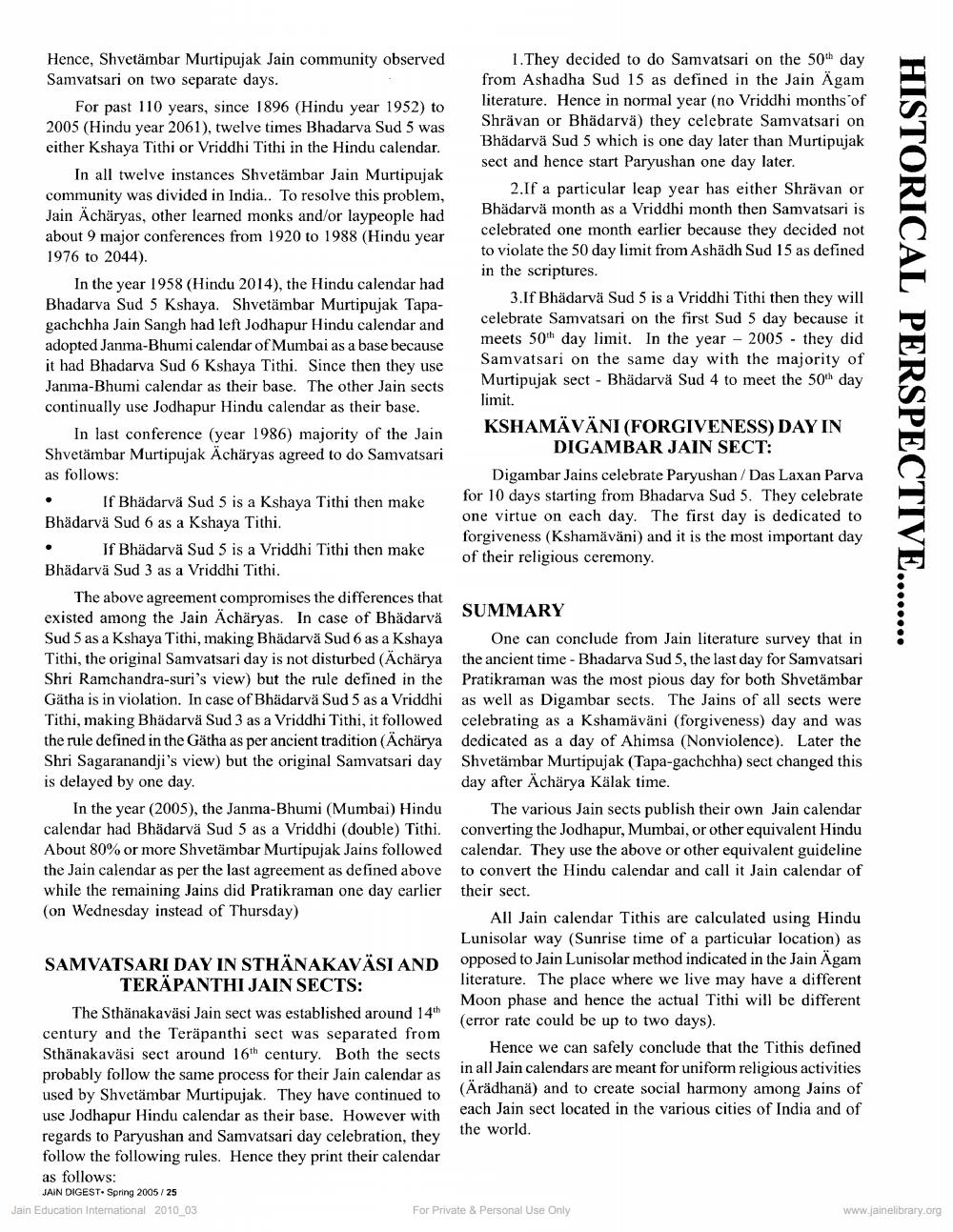________________
HISTORICAL PERSPECTIVE...
Hence, Shvetämbar Murtipujak Jain community observed 1. They decided to do Samvatsari on the 50th day Samvatsari on two separate days.
from Ashadha Sud 15 as defined in the Jain Ägam For past 110 years, since 1896 (Hindu year 1952) to
literature. Hence in normal year (no Vriddhi months of 2005 (Hindu year 2061), twelve times Bhadarva Sud 5 was
Shrävan or Bhädarvä) they celebrate Samvatsari on either Kshaya Tithi or Vriddhi Tithi in the Hindu calendar.
Bhädarvä Sud 5 which is one day later than Murtipujak
sect and hence start Paryushan one day later. In all twelve instances Shvetämbar Jain Murtipujak community was divided in India. To resolve this problem,
2.If a particular leap year has either Shrävan or Jain Achäryas, other learned monks and/or laypeople had
Bhädarvä month as a Vriddhi month then Samvatsari is
celebrated one month earlier because they decided not about 9 major conferences from 1920 to 1988 (Hindu year 1976 to 2044).
to violate the 50 day limit from Ashädh Sud 15 as defined
in the scriptures. In the year 1958 (Hindu 2014), the Hindu calendar had Bhadarva Sud 5 Kshaya. Shvetämbar Murtipujak Tapa
3.If Bhädarvä Sud 5 is a Vriddhi Tithi then they will gachchha Jain Sangh had left Jodhapur Hindu calendar and
celebrate Samvatsari on the first Sud 5 day because it adopted Janma-Bhumi calendar of Mumbai as a base because
meets 50th day limit. In the year - 2005 - they did it had Bhadarva Sud 6 Kshaya Tithi. Since then they use
Samvatsari on the same day with the majority of Janma-Bhumi calendar as their base. The other Jain sects
Murtipujak sect - Bhädarvä Sud 4 to meet the 50 day continually use Jodhapur Hindu calendar as their base.
limit. In last conference (year 1986) majority of the Jain
KSHAMÄVÄNI (FORGIVENESS) DAY IN Shvetämbar Murtipujak Achäryas agreed to do Samvatsari
DIGAMBAR JAIN SECT: as follows:
Digambar Jains celebrate Paryushan/Das Laxan Parva • If Bhädarvä Sud 5 is a Kshaya Tithi then make
for 10 days starting from Bhadarva Sud 5. They celebrate Bhädarvä Sud 6 as a Kshaya Tithi.
one virtue on each day. The first day is dedicated to
forgiveness (Kshamäväni) and it is the most important day • If Bhädarvä Sud 5 is a Vriddhi Tithi then make
of their religious ceremony. Bhädarvä Sud 3 as a Vriddhi Tithi.
The above agreement compromises the differences that existed among the Jain Ächäryas. In case of Bhädarvå SUMMARY Sud 5 as a Kshaya Tithi, making Bhädarvä Sud 6 as a Kshaya One can conclude from Jain literature survey that in Tithi, the original Samvatsari day is not disturbed (Acharya the ancient time - Bhadarva Sud 5, the last day for Samvatsari Shri Ramchandra-suri's view) but the rule defined in the Pratikraman was the most pious day for both Shvetämbar Gätha is in violation. In case of Bhädarvä Sud 5 as a Vriddhi as well as Digambar sects. The Jains of all sects were Tithi, making Bhädarvä Sud 3 as a Vriddhi Tithi, it followed celebrating as a Kshamaväni (forgiveness) day and was the rule defined in the Gätha as per ancient tradition (Acharya dedicated as a day of Ahimsa (Nonviolence). Later the Shri Sagaranandji's view) but the original Samvatsari day Shvetämbar Murtipujak (Tapa-gachchha) sect changed this is delayed by one day.
day after Acharya Kälak time. In the year (2005), the Janma-Bhumi (Mumbai) Hindu The various Jain sects publish their own Jain calendar calendar had Bhädarvä Sud 5 as a Vriddhi (double) Tithi. converting the Jodhapur, Mumbai, or other equivalent Hindu About 80% or more Shvetämbar Murtipujak Jains followed calendar. They use the above or other equivalent guideline the Jain calendar as per the last agreement as defined above to convert the Hindu calendar and call it Jain calendar of while the remaining Jains did Pratikraman one day earlier their sect. (on Wednesday instead of Thursday)
All Jain calendar Tithis are calculated using Hindu
Lunisolar way (Sunrise time of a particular location) as SAMVATSARI DAY IN STHÄNAKAVÄSI AND opposed to Jain Lunisolar method indicated in the Jain Agam TERÄPANTHI JAIN SECTS:
literature. The place where we live may have a different
Moon phase and hence the actual Tithi will be different The Sthänakaväsi Jain sect was established around 14th
(error rate could be up to two days). century and the Teräpanthi sect was separated from Sthänakaväsi sect around 16th century. Both the sects
Hence we can safely conclude that the Tithis defined probably follow the same process for their Jain calendar as
in all Jain calendars are meant for uniform religious activities used by Shvetämbar Murtipujak. They have continued to (Aradhana) and to create social harmony among Jains of use Jodhapur Hindu calendar as their base. However with
each Jain sect located in the various cities of India and of regards to Paryushan and Samvatsari day celebration, they
the world. follow the following rules. Hence they print their calendar as follows:
JAIN DIGEST. Spring 2005 / 25 Jain Education Intemational 2010_03 For Private & Personal Use Only
www.jainelibrary.org




